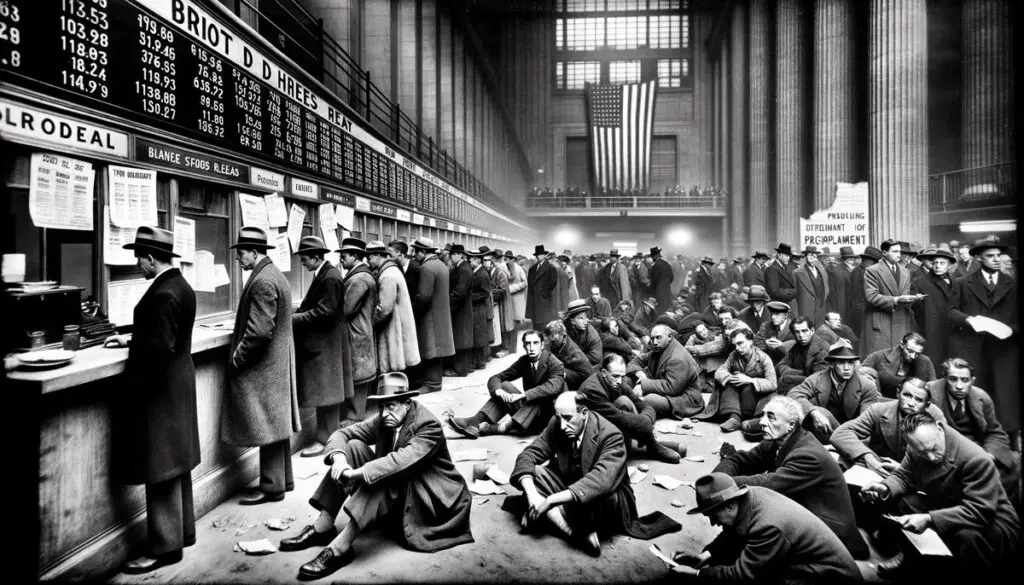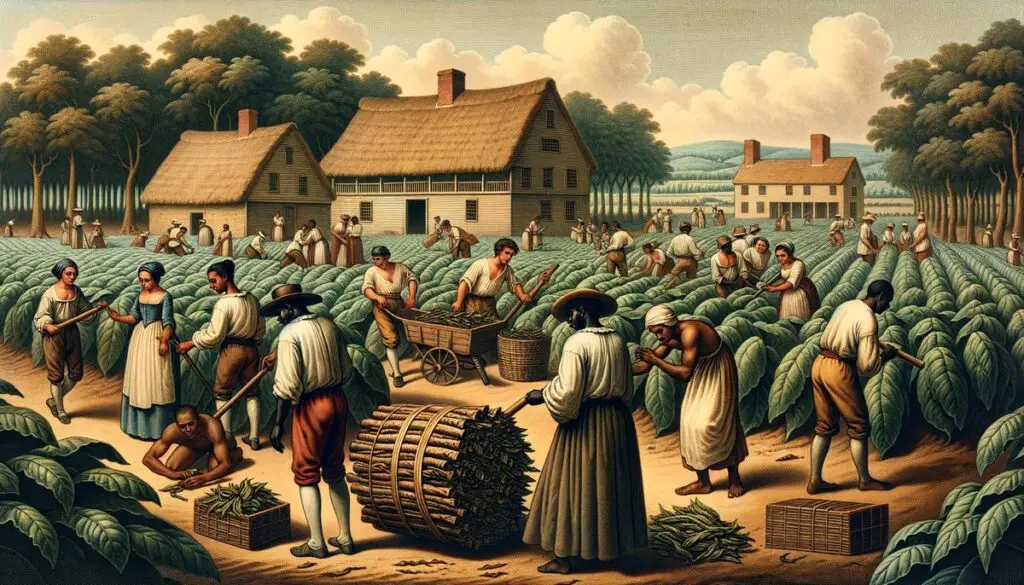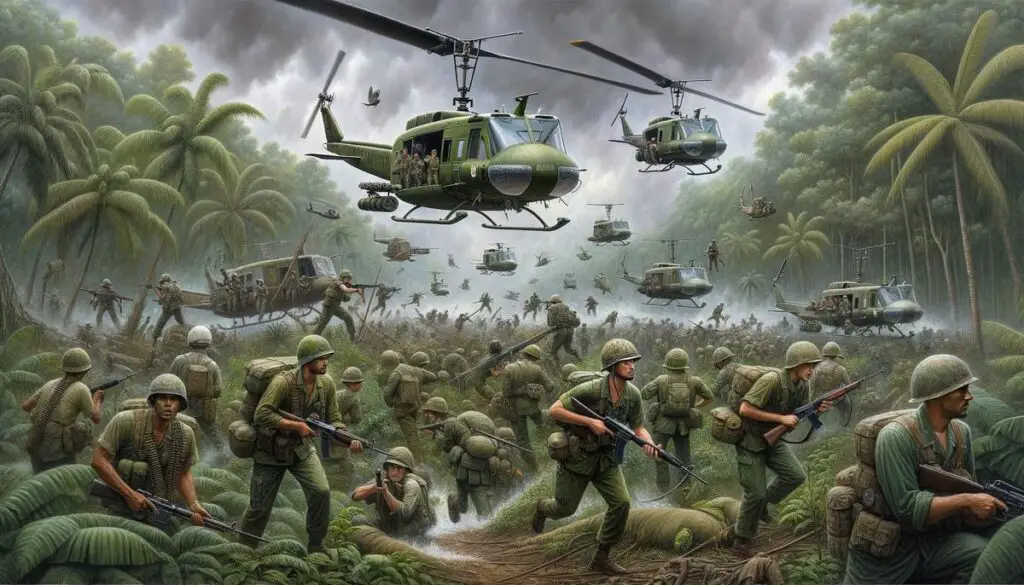The Great Depression remains one of the most significant and transformative events in American history, deeply affecting the economy and society in countless ways. This article endeavors to explore the myriad factors that contributed to its onset, the profound impact it had on everyday life, and the extensive measures undertaken by the government to steer the country towards recovery. By examining these elements, we gain insight into the interconnectedness of economic systems, the resilience of communities, and the pivotal role of policy in shaping the nation’s future.
The Onset of the Great Depression
The Great Depression, a period of economic downturn that ravaged the United States and much of the world from 1929 until the late 1930s, stands as one of the most severe financial crises in history. Its onset was triggered by a combination of factors, weaving a complex tapestry of cause and effect that led to widespread unemployment, business failures, and a significant loss of confidence in the economy.
One of the primary catalysts of the Great Depression was the stock market crash of October 1929. Known as Black Tuesday, the steep decline in stock values abruptly ended the prosperity of the 1920s, wiping out millions of investors. However, the stock market’s collapse was not the sole cause but rather a symptom of deeper economic issues.
Over-speculation in the stock market, where investors believed the good times would last forever, led to inflated stock prices. Many people were buying stocks on margin, which meant they paid only a fraction of the stock’s value and borrowed the rest, betting that the stock’s price would continue to rise. When the market crashed, they were unable to pay back these loans, compounding the crisis.
The banking system struggled under the weight of the crash. As banks had invested heavily in the stock market, the downturn eroded their assets, causing a crisis of confidence among depositors. Without the protections of modern regulations and insurance, a wave of bank failures ensued when panicked depositors attempted to withdraw their savings, leading to a devastating loss of life savings for many Americans.
Another significant factor was the decline in consumer spending and investment. As uncertainty and fear gripped the nation, people held on to their money rather than spending it. This reduction in the demand for goods and services forced businesses to cut back on production, leading to layoffs and further decreases in consumer spending, creating a vicious cycle.
International trade also played a role in exacerbating the Depression. In an effort to protect American industries, the government passed the Smoot-Hawley Tariff in 1930, which imposed high taxes on imports. This move led other countries to retaliate with their own tariffs, significantly reducing global trade and further depressing American manufacturing and agriculture.
Lastly, drought conditions, particularly in the Great Plains, struck a fatal blow to the agricultural sector. Already weakened by a decline in crop prices, the Dust Bowl, as it came to be known, devastated farms, displacing hundreds of thousands of people, further hurting the national economy.
In summary, the Great Depression was the result of a perfect storm of financial speculation, banking failures, reduction in spending and investment, international trade barriers, and environmental disaster. Its profound impact on the global economy and on the lives of millions of people underscores the interconnectedness of economic systems and the importance of sound financial and regulatory policies.
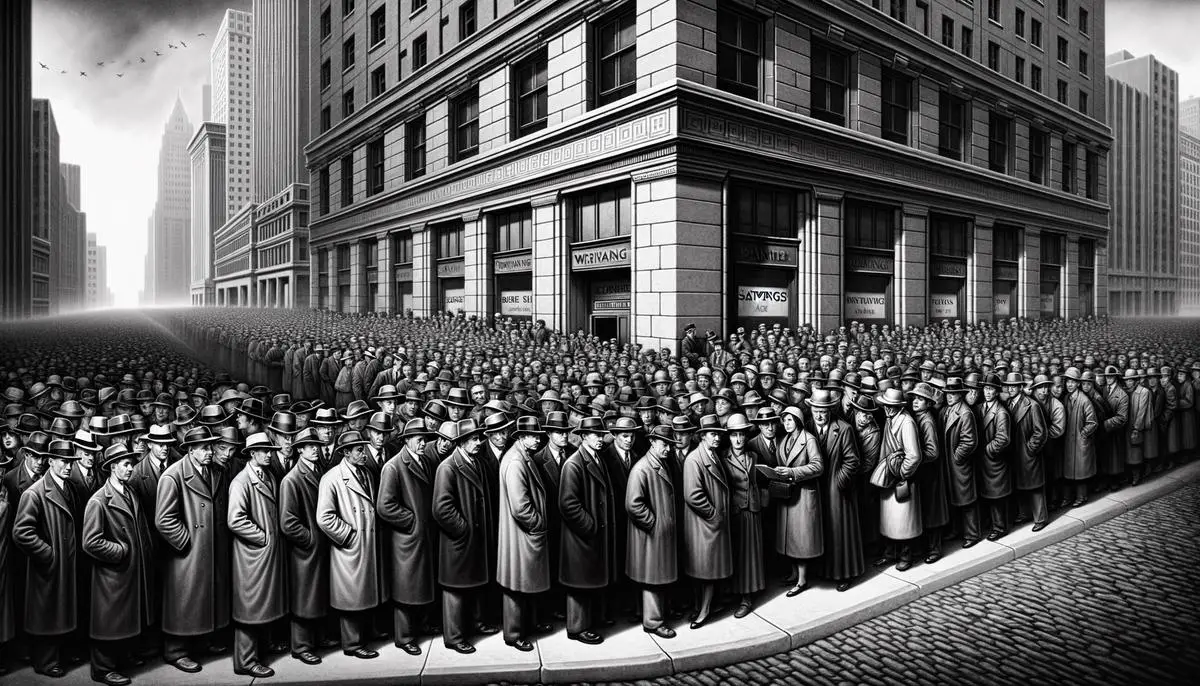
Life During the Great Depression
As the Great Depression dug its heels into American life, the fabric of society transformed in profound ways. With a quarter of the workforce unemployed, those still with jobs faced stark realities. Wages plummeted, and the security once felt by Americans dissipated into the air, much like the dust that swept through the plains.
Family dynamics shifted significantly during this era. The common model of single-earner households, where the man worked and the woman managed the home, was upended. Desperate times called for all hands on deck. Women, and even children, sought employment to keep families afloat. Despite societal reluctance to accept women in the workforce, necessity trumped tradition, and women found roles beyond the expected, albeit often at significantly lower wages than their male counterparts.
The crisis wasn’t limited to economics alone. The psychological impact of the Depression was monumental. Men, traditionally seen as the breadwinners, found themselves unable to fulfill this role, leading to feelings of inadequacy and despair. The lack of work and the struggle to provide for families contributed to a sharp rise in mental health issues. Families were not only fighting for survival but were also grappling with the emotional weight of their circumstances.
Education witnessed a downturn as well. With finances stretched thin, many families couldn’t afford school supplies or were forced to pull children from school entirely to work. Schools faced their own challenges, struggling with funding cuts, which led to teacher layoffs, larger class sizes, and in some extreme cases, school closures. The intellectual and cultural growth of a generation was stunted, impacting future opportunities.
Social life during the Depression shifted as Americans sought solace and escape from their hardships. Community and entertainment underwent transformation; free or low-cost pastimes became the norm. People gathered around radios to listen to broadcasts, providing a free form of entertainment and a temporary escape from their worries. Board games, card games, and other home-based activities saw a resurgence. Likewise, the arts flourished in unique ways as people used creativity to express their struggles, hopes, and resilience.
Travel and mobility decreased significantly. The golden age of the automobile was halted by the economic downturn. Cars were abandoned or sold as luxuries that many could no longer afford, marking a stark contrast to the boom of the 1920s when the automobile symbolized prosperity and freedom. This retreat from mobility further isolated rural communities and tightened the radius of people’s lives.
Community support systems became critical. Soup kitchens, bread lines, and other forms of direct aid offered vital sustenance to those hardest hit. The harshness of the era fostered a spirit of community and a sense of solidarity among many Americans. Neighbors helped neighbors, sharing whatever little they had. This period also saw the rise of significant government intervention in the economy and social welfare, leading to the establishment of programs aimed at providing relief, recovery, and reform. These efforts laid the groundwork for the modern social safety net in the United States.
In essence, daily life during the Great Depression was characterized by a fight for survival. The economic collapse led to a radical restructuring of family, social, and educational life. Yet, amid the hardships, Americans found ways to adapt, cope, and support one another, showcasing resilience in the face of adversity.
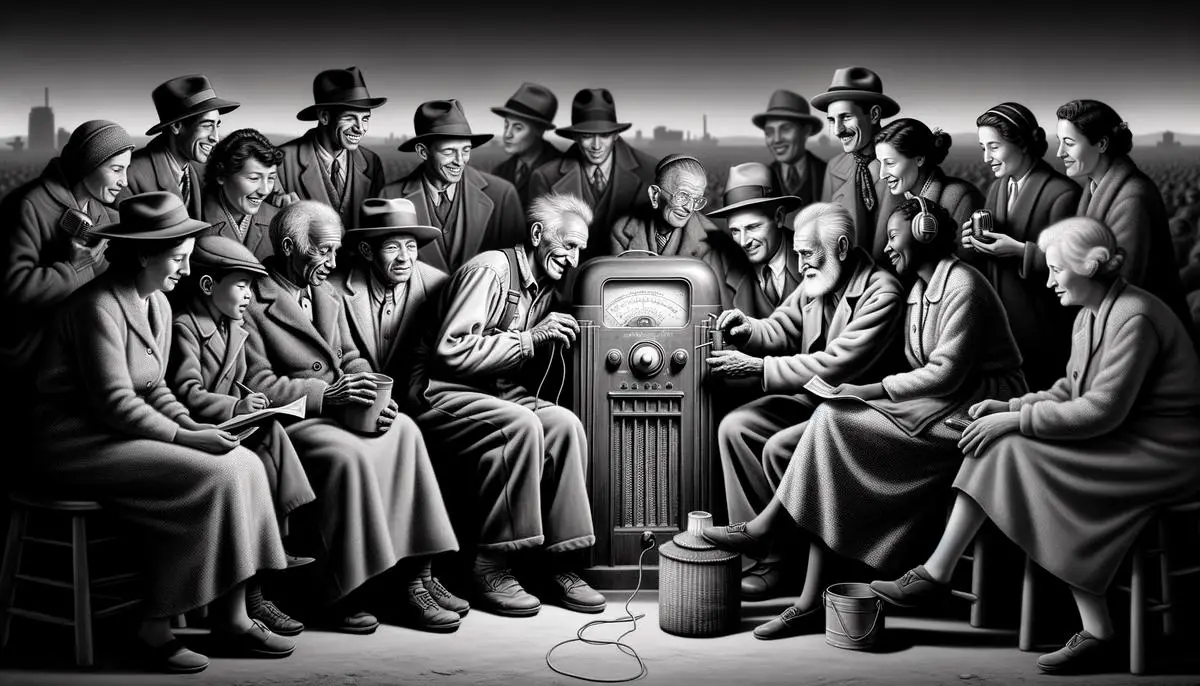
Government Response to the Crisis
In addressing the monumental challenge of the Great Depression, the U.S. government, under the leadership of President Franklin D. Roosevelt, embarked on a bold and unprecedented series of programs and policies collectively known as the New Deal. These initiatives aimed not only to provide immediate relief to millions suffering from the economic downturn but also to lay the groundwork for a more resilient and equitable economic system.
One of the first steps taken was the establishment of the Emergency Banking Act of 1933, which sought to stabilize the banking system. By declaring a bank holiday and closing financial institutions temporarily, the government was able to reassess and reorganize banks in a controlled environment, restoring public confidence in the banking sector. Following this, the Federal Deposit Insurance Corporation (FDIC) was created to insure deposits, helping prevent future bank runs.
Understanding the need for immediate job creation, the government established several work-relief programs. The Civilian Conservation Corps (CCC) and the Works Progress Administration (WPA) stand out for their roles in providing employment to millions of Americans. These agencies were responsible for a wide range of public works projects, including the construction of roads, bridges, parks, and public buildings, which not only offered immediate employment but also improved the nation’s infrastructure.
The Agricultural Adjustment Act (AAA) addressed the plight of farmers by providing payments to reduce crop production, thus raising prices. By tackling the problem of overproduction, the AAA aimed to increase agricultural income and halt the vicious cycle of falling prices and declining demand.
Another significant aspect of the New Deal was the introduction of social security measures. The Social Security Act of 1935 established a system of unemployment insurance, old-age benefits, and disability insurance. This landmark legislation laid the foundation for the modern welfare state by ensuring a safety net for the most vulnerable in society.
The government also focused on reforming the financial sector to prevent future crises. The Securities and Exchange Commission (SEC) was established to regulate the stock market, aiming to curb the kind of speculative practices that led to the 1929 crash. Similarly, the Glass-Steagall Act separated commercial and investment banking to reduce risks to the financial system.
Furthermore, the government sought to assist homeowners and farmers facing foreclosure through the establishment of the Home Owners’ Loan Corporation (HOLC) and the Farm Credit Administration. These agencies helped restructure loans under more favorable terms, preventing loss of homes and farms and stabilizing the housing and agricultural sectors.
Through these and other measures, the New Deal represented a profound shift in the role of the federal government in American economic and social life. It not only aimed to mitigate the immediate effects of the Great Depression but also to lay the groundwork for long-term economic stability and social welfare. The New Deal’s legacy, with its emphasis on government responsibility for the welfare of its citizens, continues to influence the United States’ approach to economic policy and social programs.
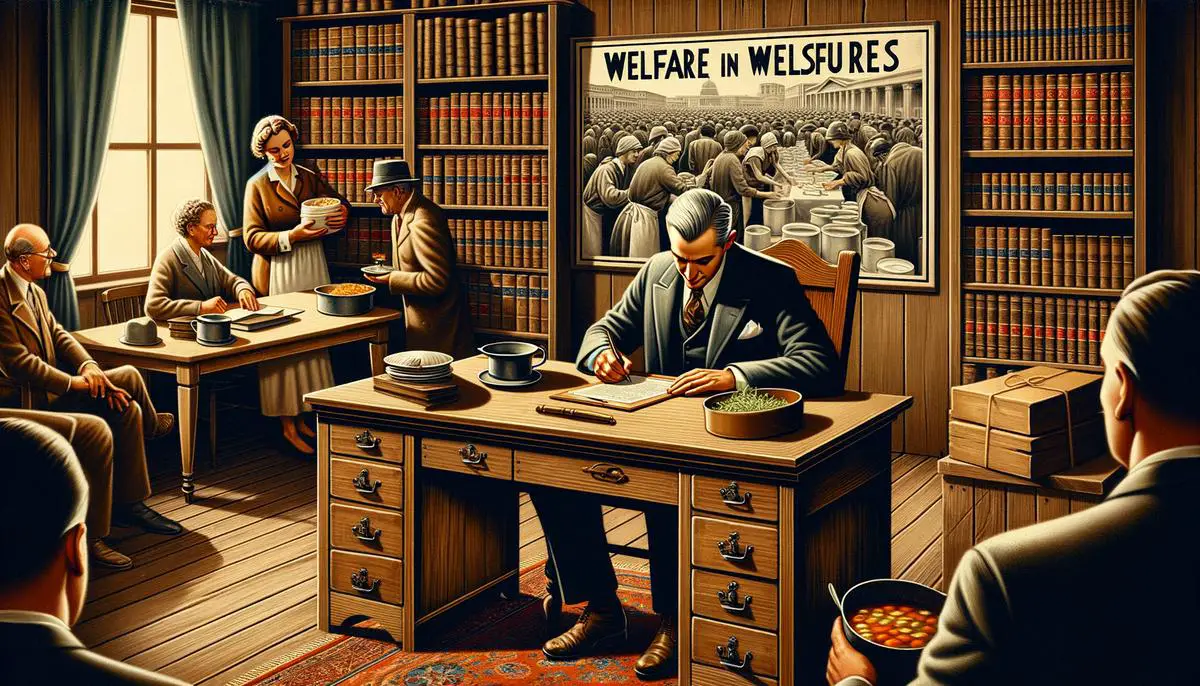
The Great Depression in Popular Culture
Popular culture during the Great Depression played a crucial role in shaping public perception, offering both an escape from and a reflection of the challenges faced by the American people during this tumultuous time. Movies, music, radio programs, and literature not only became outlets for entertainment but also powerful mediums for communicating the experiences, struggles, and resilience of the nation.
Hollywood, in particular, rose to the occasion by producing films that either provided a temporary reprieve from the harsh realities of the Depression or depicted those realities in ways that resonated with the average American. The era saw the rise of movie genres that remain popular today, including screwball comedies, which made light of romantic and social conflicts, and gangster films, which often showcased the dark underbelly of American society. Movies like “It Happened One Night” and “Public Enemy” captivated audiences by offering humor and drama that diverted their attention from daily struggles. Meanwhile, the implementation of the Hays Code in 1934 began to regulate the content of films, ensuring that they conveyed appropriate moral messages.
Radio also became a staple in American homes, with families gathering around to listen to comedies, dramas, and variety shows. Programs like “The Shadow” and “Amos ‘n’ Andy” entertained millions, while President Franklin D. Roosevelt’s “Fireside Chats” used the medium to directly communicate with the American public, offering hope and explaining government policies.
The Depression era was also marked by significant contributions to music and literature that reflected the zeitgeist of the times. Folk and blues music, with artists such as Woody Guthrie, articulated the plight and strength of the working class. Guthrie’s songs, like “This Land Is Your Land,” became anthems highlighting the struggles and resilience of the American people. Similarly, literature from authors like John Steinbeck in “The Grapes of Wrath” provided profound social commentary on the era, painting vivid pictures of the impact of the Great Depression on American families and the stark realities of poverty, displacement, and hopelessness.
Despite the pervasive gloom of the Great Depression, popular culture managed to both mirror and mold public perception, offering solace, reflection, and sometimes, a bit of humor. It played a fundamental role in maintaining a sense of normalcy and continuity in American life, even as the country navigated one of the most challenging periods in its history. Through films, radio, music, and literature, popular culture during the Great Depression not only entertained but also bolstered the spirit of a nation, making it an indelible part of the American identity that endures in memory and influence to this day.
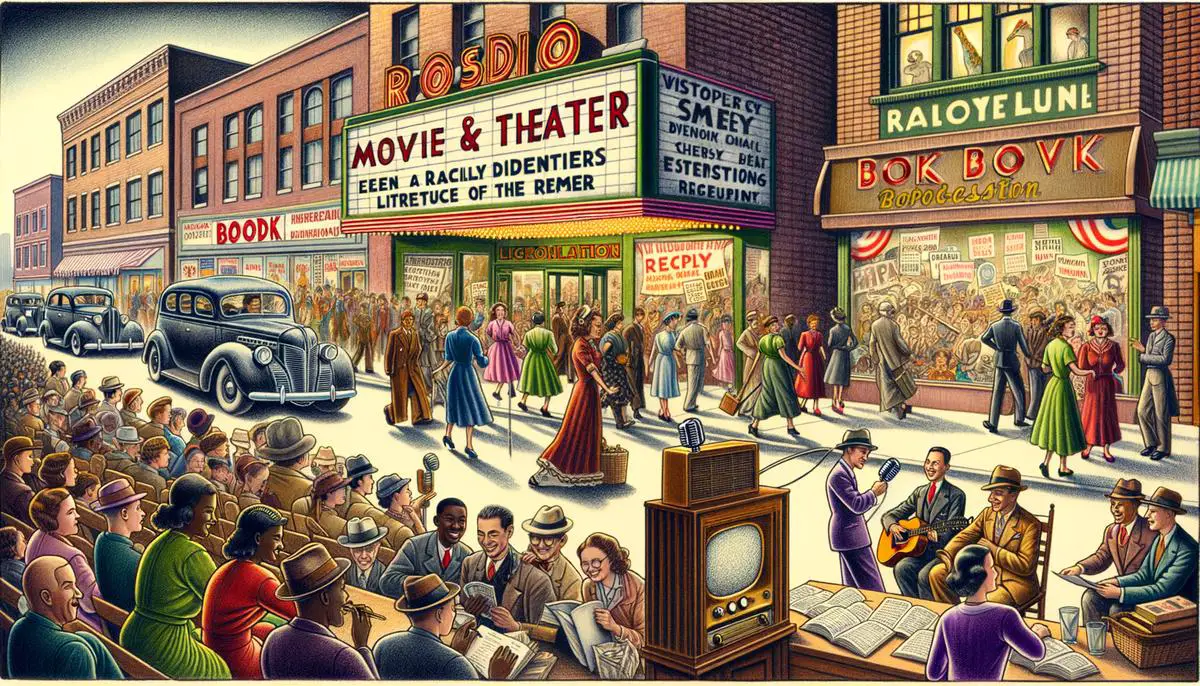
The Road to Recovery
The culmination of the Great Depression, an era marked by widespread economic hardship and social change, was the result of a mosaic of factors working in tandem to restore economic stability and public confidence. At the forefront of these revival efforts was the leadership of President Franklin D. Roosevelt, whose New Deal policies were instrumental in reshaping the economic and social landscape of the United States.
Key to this recovery was the adaptation and resilience of the American workforce. The New Deal’s focus on job creation, exemplified by programs like the Civilian Conservation Corps (CCC) and the Works Progress Administration (WPA), not only provided immediate relief but also revitalized infrastructure, laying the foundation for long-term economic growth. These programs were pivotal in not just mitigating unemployment but also in instilling a sense of purpose and hope among the populace.
Moreover, comprehensive reforms aimed at stabilizing the financial sector played a critical role in preventing a recurrence of the factors that led to the Depression. The establishment of the Federal Deposit Insurance Corporation (FDIC) and the Securities and Exchange Commission (SEC), along with the enforcement of the Glass-Steagall Act, restored trust in the banking system and regulated stock market practices, ensuring a level of safety and confidence that had been sorely lacking.
Another significant factor was the shift in government philosophy regarding welfare and economic intervention. The introduction of the Social Security Act of 1935 represented a landmark shift towards a welfare state, acknowledging the government’s role in providing for the economic security and welfare of its citizens. This was a monumental step in redefining the social contract between the government and the people, ensuring a safety net for the vulnerable and laying the groundwork for a more equitable society.
The economic stimulus provided by World War II also cannot be overlooked. The demand for military supplies and the subsequent mobilization of the workforce led to a surge in industrial production, effectively pulling the national economy out of the doldrums. This not only underscored the importance of government spending in stimulating economic growth but also marked the beginning of what would be a prolonged period of economic prosperity.
Finally, the impact of cultural shifts during this period played a subtle yet significant role in the recovery. The solidarity and resilience displayed by communities, the inspiring tales of perseverance depicted in literature and film, and the soothing reassurances of President Roosevelt’s “Fireside Chats” collectively maintained morale and fostered a sense of unity and common purpose among the American people. This cultural backdrop was instrumental in sustaining public spirit and optimism during the recovery period.
In sum, the end of the Great Depression was the result of a multifaceted approach that included significant policy reforms, governmental shifts towards welfare and economic intervention, and a cultural resilience that upheld the nation’s spirit. The legacy of this era, marked by its profound economic reforms and cultural shifts, continues to influence the American socioeconomic landscape to this day. Through a combination of innovative New Deal policies, financial reforms, and a collective cultural resilience, the United States emerged from one of its darkest periods with renewed strength and a redefined vision of economic and social prosperity.
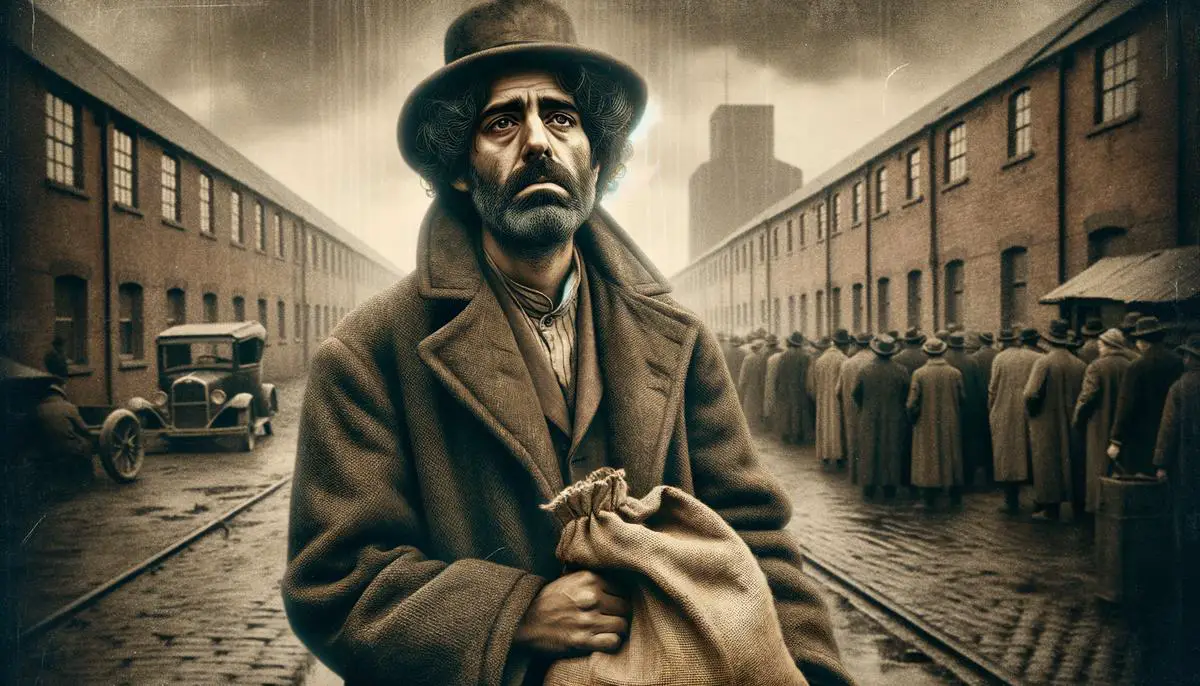
Through a comprehensive examination of the causes, experiences, and responses to the Great Depression, this article has illuminated the multifaceted nature of this historic crisis and the ensuing recovery. The era taught invaluable lessons about the vital importance of economic stability, social welfare, and community solidarity, leaving an indelible mark on American consciousness. By reflecting on this period of hardship and resilience, we better appreciate the enduring spirit of innovation and cooperation that defines the American experience, affirming the nation’s capacity to overcome even the most daunting challenges.
- Julius Caesar Adaptations - April 15, 2024
- Declaration of Independence - April 15, 2024
- US Civil War Analysis - April 14, 2024

